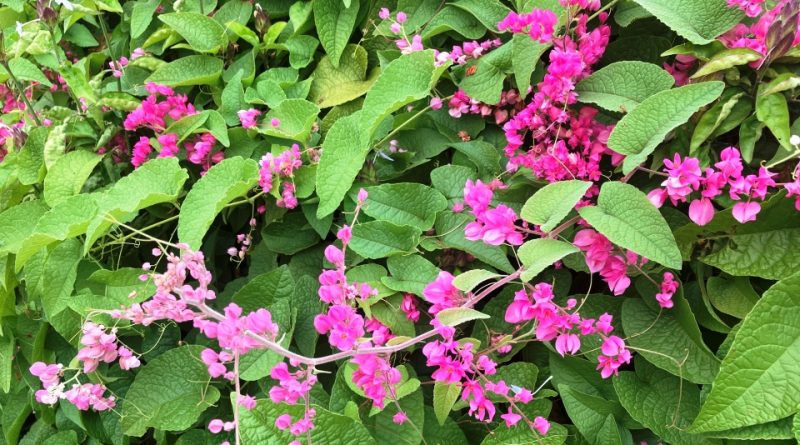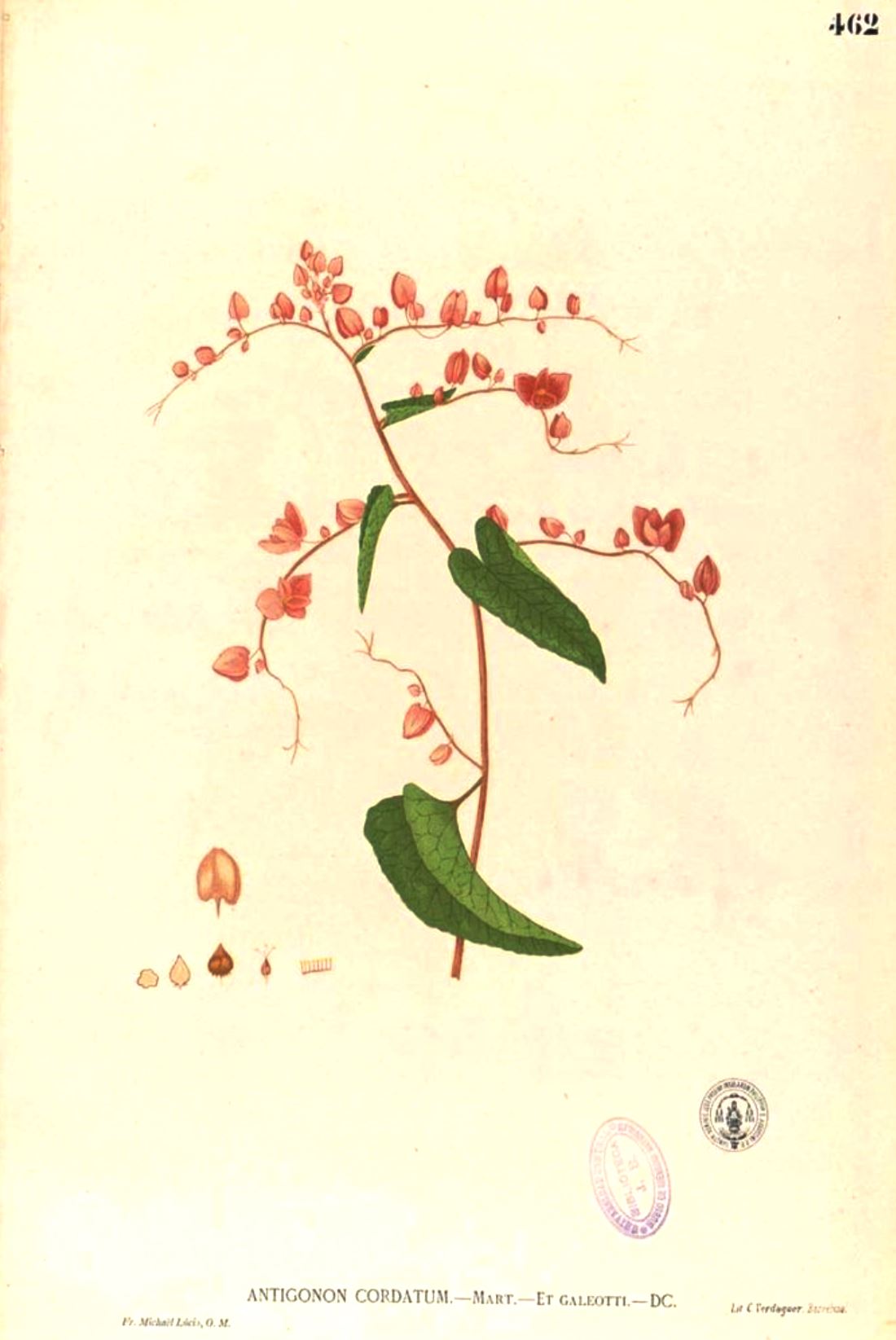Antigonon leptopus
Antigonon leptopus
The coral vine (Antigonon leptopus Hook. & Arn.) is a climbing shrub species belonging to the Polygonaceae family.
Systematics –
From a systematic point of view it belongs to:
Eukaryota domain,
Kingdom Plantae,
Subkingdom Tracheobionta,
Magnoliophyta division,
Class Magnoliopsida,
Subclass Caryophyllidae,
Order Polygonales,
Polygonaceae family,
Subfamily Eriogonoideae,
Genus Antigonon,
Species A. leptopus.
The terms are synonyms:
– Antigonon amabie K.Koch;
– Antigonon cinerascens Mart. & Galeotti;
– Antigonon cordatum Mart. & Galeotti;
– Antigonon platypus Hook. & Arn.;
– Corculum leptopus (Hook. & Arn.) Stuntz;
– Corculum leptopus var. album Stuntz;
– Polygonum cirrhosum Moc. & Sessé;
– Polygonum cirrhosum Moc. & Sessé ex Meisn..
Etymology –
The term Antigonon is of uncertain origin, according to some authors it derives from the Greek “anti”, against and “gόnia”, angle, with reference to the angular stems but it could also refer to Antigono, a character from Greek mythology associated with the struggle or resistance .
The specific epithet leptopus is the combination of the Greek terms “leptos”, thin and “pus, podόs”, foot, with reference to the thin stems.
Geographic Distribution and Habitat –
Antigonon leptopus is a species of perennial vine native to the coastal plains of the Pacific and the Atlantic area of Mexico (Baja Sur, Chihuahua, Guerrero, Jalisco, Michoacan, Nayarit, Oaxaca, Sinaloa and Sonora) but also occurs as a weed in some areas such as along roads running from southern Mexico to Central America.
On the Pacific coast, this species is found north of the Sierra de la Giganta in Baja California Sur, the islands of the Gulf of California and northern Sonora. On the Atlantic coast, this species is found in northern Tamaulipas. Its range extends south and inland from the Pacific side to Jalisco, becoming more sporadic through Guerrero and Michoacán, on the Atlantic side, through Veracruz, with both sides of the range converging in central Oaxaca.
Its natural habitat is that of the low deciduous forest, mainly in open areas, up to about 900 m of altitude, but it can reach up to 1,500 meters in Guatemala; however this plant occupies a variety of habitats, but prefers sandy soils and is shade intolerant. In Baja California Sur, this species occurs mostly naturally in flat areas and on hillsides. The plant climbs cacti and trees, and overwhelms shrubs and rocks. A. leptopus inhabits a range of different environments on the peninsula, from islands and desert on the Gulf Coast, the Magdalena Plains, Sierra de la Giganta, Sierra de la Laguna and the xeric plains of the Cape. It is also present as a roadside weed and used as an ornamental plant for fences; it can especially be seen along the Mexican Federal Highway, near the Sierra de la Giganta.
This plant has been introduced and has become invasive in all tropical regions of the world, including the southern and eastern United States, the West Indies, South America, and tropical parts of Asia and Africa.
Description –
Antigonon leptopus is a climbing plant, with tendrils present at the ends of the inflorescences.
The roots are tuberous and can reach 1-2 (-10) m in length.
The stem has internodes 1 to 10 cm long and 1 to 4 mm thick, with sparse to dense hairs; ocrea (sheath enveloping the internode of the stem or branch for a more or less long distance above the insertion of the leaf) reduced to a thickened line surrounding the stem.
The leaves are alternate, spiraled, simple, with a 4 to 30 mm long and 0.5 to 1.5 mm thick petiole; the laminae are largely ovate to sagittate, 4-12 cm long by 2,4-6 cm broad, papery, with brown hairs, entire to wavy margin, acute to acuminate apex, subcordate to cordate base, pinnate veins .
The inflorescences are in an axillary and terminal position, they are racemose, with grouped and alternate flowers, the racemes form 12 to 20 cm long panicles, with the branches of the inflorescence ending in tendrils.
The flowers, pink or white, are bisexual; perianth with 5 segments, ovate-chordate, (4-) 6-12 mm long, pink to rose-red, the three outer ones wider than the inner ones, persistent and growing in the fruit; stamens 8, free from the perianth, inserted at the base of the ovary, filaments united in a short tube, filiform, hairless, introverted anthers (open towards the inside of the flower), punctures; superior ovary largely trigone, unicarpellate, unilocular; ovule 1, basal; styles 3; stigmas 3, peltate.
The anthesis goes from spring to autumn.
The fruit is an achene enclosed by the perianth, elongated, brown, smooth, shiny, hairless, 0,8-1,2 cm long; inside we find a seed, triangular, compressed, with a flat and erect embryo.
Cultivation –
Antigonon leptopus is a very fast growing plant that produces large clusters of pink flowers and is often grown as an ornamental plant in tropical and subtropical areas.
Furthermore, it is widely cultivated, as well as an ornamental plant, as a ground cover; the plant is also sometimes harvested for its edible roots and leaves.
This species is used for its edible tubers and seeds, but also for its horticultural properties as an ornamental vine in warmer parts of the world.
As mentioned, it is a climbing plant with particularly fast growth and of great ornamental value due to the copious and brilliant flowering which lasts for a long period in summer-autumn. The plant can be cultivated in the tropical, subtropical climate zones and marginally, in a sheltered, warm temperate position, where it often behaves as deciduous and loses the aerial part with temperatures around the 0 °C; in these areas, however, it grows back in spring from the roots, which can resist, with a good mulch, at values of a few degrees lower for a short time.
The plant requires full sun and is not particular about the soil, even if poor, and well rooted it resists periods of drought, therefore suitable for areas with long and dry summers, naturally in this situation regular and abundant watering ensures an even more vigorous growth . Can be used as ground cover or climber on trees, trellises, railings and pergolas that it can cover in a short time.
The plant is a prolific seed producer, the seeds being spread by water and wild animals. Often runs away from cultivation. It grows well in disturbed areas and adapts well to dry coral reefs and derived soils. It tolerates drought by defoliation and grows back strongly after rain. It can completely choke out native plants in the rainy season, overtaking vines and undergrowth plants. The leaves dry up and fall off during the dry season, providing fuel for particularly damaging fires.
It reproduces by seed, which germinates in 3-4 weeks at the temperature of 20-22 °C and with which it easily propagates becoming, under favorable conditions, weed, by root suckers, cutting and layering.
Customs and Traditions –
Antigonon leptopus is a plant known by various names: Confite (Guatemala); Coral (Honduras); Flor de San Diego (Oaxaca, Yucatán, Veracruz); enredadera de San Diego (Nuevo León, Oaxaca); rose de mayo (Sinaloa); corona de reina (Tamaulipas); hierba de Santa Rosa (Morelos); San Miguelito (Sonora, Sinaloa); lightning (Guerrero, Morelos); flor de San Miguel (Sonora); coronilla (Sinaloa). Martínez (1979) also mentions the following names: cadena de amor, confite, corona, corona de la reina, coronela, jololito, paraguayita, rosa de mayo, San Diego, San Miguel, San Miguelito, La Flor del Coralillo y bellísima, Flor de Paty (Tlaquepaque).
The tuberous roots are edible and were consumed by local populations in times of famine.
Among the edible uses, therefore, the tuberous root is consumed which can be cooked and eaten and has a taste similar to the nut.
The roots usually carry small tubers, but sometimes they can weigh up to 7 kilos.
The leaves and flowers can also be eaten cooked.
On the other hand, there is no news of medicinal uses.
Other uses include agroforestry.
The plant can be grown as a ground cover or by allowing it to climb other plants.
It grows rapidly and has also been used to provide very rapid green cover for buildings, walls, etc.
From an ecological point of view, the seeds float on water. The fruits and seeds are eaten and spread by a wide range of animals such as pigs, raccoons and birds. The tubers will regrow if the plant is cut or damaged by frost.
Method of Preparation –
Antigonon leptopus is a plant known for some time by the local populations of its areas of origin.
Both the rhizomatous roots and leaves and flowers can be eaten cooked.
They are often cooked and used to flavor other dishes and pastas.
On the other hand, there are no references for uses in traditional medicine.
Guido Bissanti
Sources
– Acta Plantarum – Flora of the Italian Regions.
– Wikipedia, the free encyclopedia.
– GBIF, the Global Biodiversity Information Facility.
– Useful Tropical Plants Database.
– Conti F., Abbate G., Alessandrini A., Blasi C. (ed.), 2005. An annotated checklist of the Italian vascular flora, Palombi Editore.
– Pignatti S., 1982. Flora of Italy, Edagricole, Bologna.
– Treben M., 2000. Health from the Lord’s Pharmacy, Advice and experiences with medicinal herbs, Ennsthaler Editore.
Photo source:
– https://inaturalist-open-data.s3.amazonaws.com/photos/251255217/original.jpg
Attention: The pharmaceutical applications and alimurgical uses are indicated for informational purposes only, they do not in any way represent a medical prescription; we therefore decline all responsibility for their use for curative, aesthetic or food purposes.


